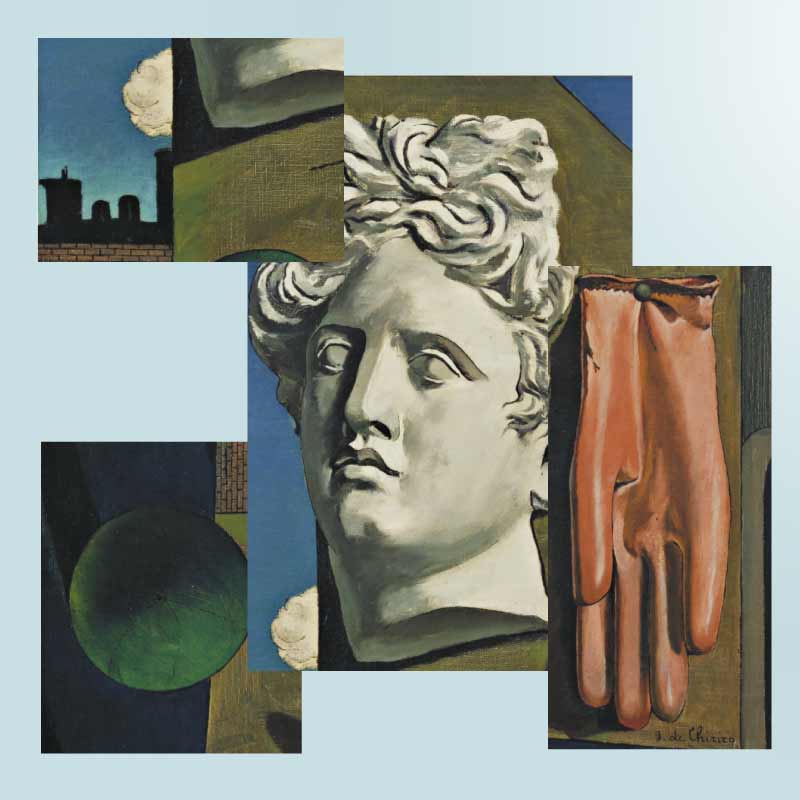FAQs – The Song Of Love
When was the Song of Love painted?
The Song of Love was painted by Giorgio de Chirico in June of the year 1914. This painting is considered as a precursor to the surrealist art movement which was finally discovered a decade later. The painting is in the Museum of Modern Art (MOMA), New York City.
What shall I love if not the enigma?
The metaphysical surrealist painter Giorgio de Chirico was deeply influenced by the philosopher Nietzsche. Chirico quoted Nietzsche’s words “And What Shall I Love If Not the Enigma” at the bottom of one of his self-portraits.
What inspired Rene Magritte?
Rene Magritte is an artist of the surrealist movement. Giorgio de Chirico’s work has largely influenced the work of all surrealists. Upon seeing Chirico’s “The Song of Love” Painting for the first time, Magritte was inconsolable. He said “to see thought for the first time” was extremely moving for him. Magritte’s most famous work “The Son of Man” has been directly inspired by Chirico’s “Song of Love”.
Elements in the Song of Love Painting
The elements in “The Song of Love” painting are largely unrelated and look extremely strange when grouped. Since the elements don’t appear to be connected in any way, it is wiser to study them separately.
Head of Apollo
One of the first elements that stand out in the painting is the bust of a Greek god. This statue is of Apollo, the god of all, particularly all forms of art and physical being.
In an attempt to overanalyze the painting, I felt that Apollo’s statue is quite fitting in this setting. In fact, Apollo’s bust would fit anywhere, because he is the god of everything. It seems as if the sculpture in a way ties all the unconnected elements and is the only common link among them.
The Glove
The glove stands out not only because of its size but also because it is so difficult to romanticize a glove artistically. The light and shading make the texture of the glove very perceivable. The glove has two important features. One is that it is the same color as flesh and the other is that it is related to hands. These two features provide a much-needed “touch” with reality to the painting.
 The Song of Love by De Chirico. Public Domain
The Song of Love by De Chirico. Public Domain
The Green Sphere
Not much can be analyzed from this green ball, so naturally, we further disintegrate it. The shape in itself symbolizes unity or perfection. The color green on the other hand represents fertility, nature, and rejuvenation. Based only on the shape this element might be an unconscious effort to make the painting more coherent. Symbolically I do not see any importance in the color of the sphere. The green however does contrast well with the reddish glove.
Lighting, Colors, and Atmosphere
The setting of the painting is one of the most important elements that give it the surreal look. Speaking of the atmosphere, it is incredibly static and has a tinge of breathlessness. Even with the moving train at the very back, it seems as if time has completely stopped.
The depth of the various elements in the background is not consistent. The blue sky has a little dimension but the train and the wall are completely flat. The train on the horizon is a common theme that makes its appearance in Chirico’s art.
Similarly, the wall with arched doors and windows on the right is more three-dimensional compared to the wall facing the viewers. Even the lighting in the picture is inconsistent. A warm light enters the frame from the top right corner slightly behind the viewer. The warmth combined with the suffocation makes the atmosphere extremely uncomfortable. The metaphysical elements in an uncomfortable setting create a unique form of anxiety common to de Chirico’s paintings.
The Metaphysical Art Movement
As the name suggests “metaphysical” implies concepts or things that do not exist physically. This art movement was put forward by Chirico and Carra during World War I.
Metaphysical art has tones of mystery, lacks logic or uniformity, and has elements that don’t apparently make sense together. Think of a dream, that doesn’t make sense. It’s normal for dreams to be outrageous and illogical, but metaphysicists applied this feature to art. An important characteristic of these paintings is the presence of familiar subjects in an incongruent but familiar setting. The scenes that are depicted are also painfully still and sometimes suffocating. While it is comforting to think that these paintings are metaphysical aka “not real”, the motive of metaphysical artists is to reveal “true reality”. The premise of this movement is to create art that unveils the physical appearance of reality.














![Песня о любвидвижение метафизического искусства [ править ] а также картина [ править ]](http://sch176zgr.ru/wp-content/uploads/9/a/6/9a618e07dfcfa5abe7b9f7669a846e6a.jpeg)










